16 Fascinating Historical Photos That You Most Probably Had No Idea About
Kenneth Coo
Published
04/23/2018
in
wow
This time we go in the darker parts of our past.
- List View
- Player View
- Grid View
Advertisement
-
1.
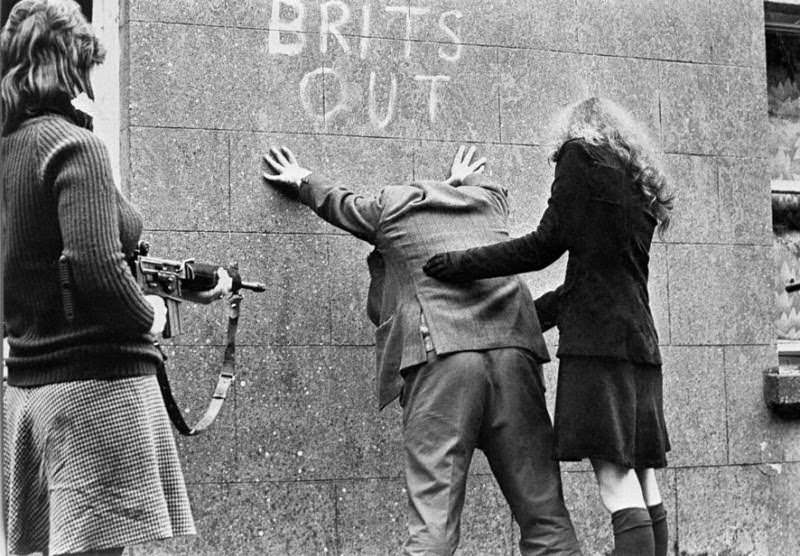 This IRA propaganda picture shows female IRA members checking a loyalist civilian for arms in Northern Ireland in 1972. This was part of a number of pictures released by the IRA showing faceless women in action. The weapons and female IRA members are real, but the scenario is staged. This kind of picture was designed to give the impression the IRA was everywhere, and could be anyone at anytime. This was during the earlier stages of The Troubles, which lasted 30 years from 1968 through 1998. Throughout this time, female IRA members often played traditional roles such as secretaries or organizers, sometimes also as spies or support roles, but plenty were also active soldiers. As the Troubles ramped up, more women joined both sides. The IRA tends to be better known, but there was also a lot of Northern Irish people who joined loyalist factions or government agencies in efforts to suppress the IRA.
This IRA propaganda picture shows female IRA members checking a loyalist civilian for arms in Northern Ireland in 1972. This was part of a number of pictures released by the IRA showing faceless women in action. The weapons and female IRA members are real, but the scenario is staged. This kind of picture was designed to give the impression the IRA was everywhere, and could be anyone at anytime. This was during the earlier stages of The Troubles, which lasted 30 years from 1968 through 1998. Throughout this time, female IRA members often played traditional roles such as secretaries or organizers, sometimes also as spies or support roles, but plenty were also active soldiers. As the Troubles ramped up, more women joined both sides. The IRA tends to be better known, but there was also a lot of Northern Irish people who joined loyalist factions or government agencies in efforts to suppress the IRA. -
2.
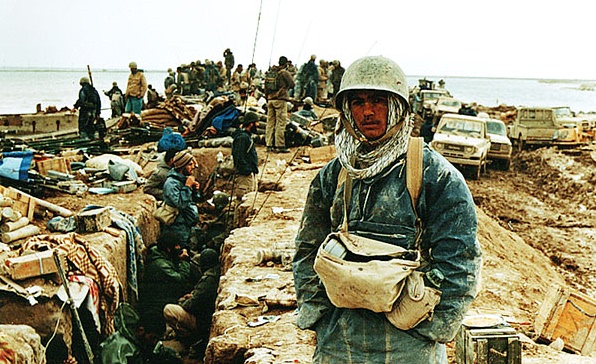 Iranian soldiers hold a position during the Iran-Iraq War in 1982. The war was a stalemate, and lasted 8 long years. It also took part the same time during the Soviet Occupation of Afghanistan, from 1980-1988. Both sides claimed victory. The Iranian Revolution worried Iraq, and border disputes turned into war in 1980. Each side fortified positions with massive trenches, and large scale trench warfare took place. Anywhere from 500,000 to a million people died during the war.
Iranian soldiers hold a position during the Iran-Iraq War in 1982. The war was a stalemate, and lasted 8 long years. It also took part the same time during the Soviet Occupation of Afghanistan, from 1980-1988. Both sides claimed victory. The Iranian Revolution worried Iraq, and border disputes turned into war in 1980. Each side fortified positions with massive trenches, and large scale trench warfare took place. Anywhere from 500,000 to a million people died during the war. -
3.
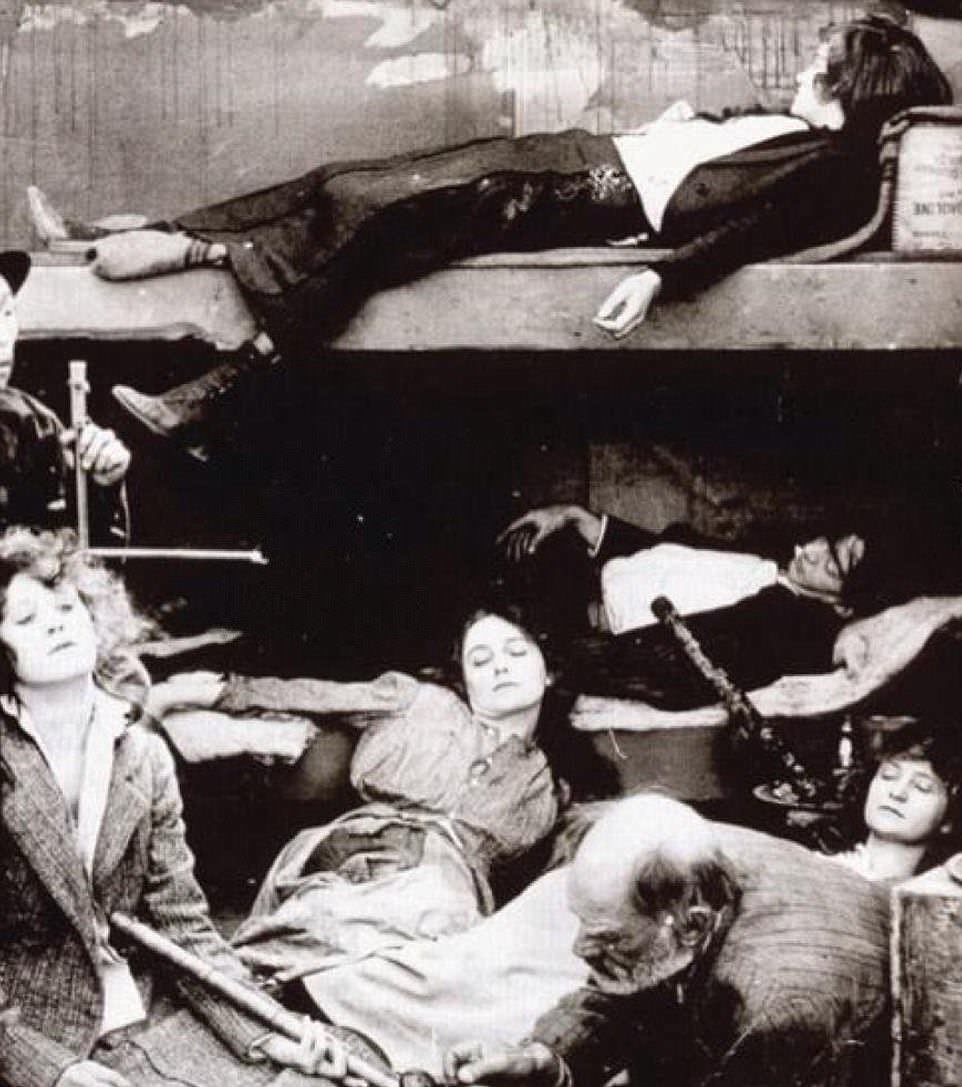 Women high on opium in NYC, US in 1925. Women often got inferior pipes because the Chinese thought that if a woman used a good quality pipe, it became worthless and was likely to split. This also caused health issues for women as their intake of opium was out of balance often. Opium was the biggest drug of the 1800s and early 1900s, and has been around for over 2 thousand years. It is turned into heroin into a more potent form, and was the key drug used to subdue pain prior to Morphine.
Women high on opium in NYC, US in 1925. Women often got inferior pipes because the Chinese thought that if a woman used a good quality pipe, it became worthless and was likely to split. This also caused health issues for women as their intake of opium was out of balance often. Opium was the biggest drug of the 1800s and early 1900s, and has been around for over 2 thousand years. It is turned into heroin into a more potent form, and was the key drug used to subdue pain prior to Morphine. -
4.
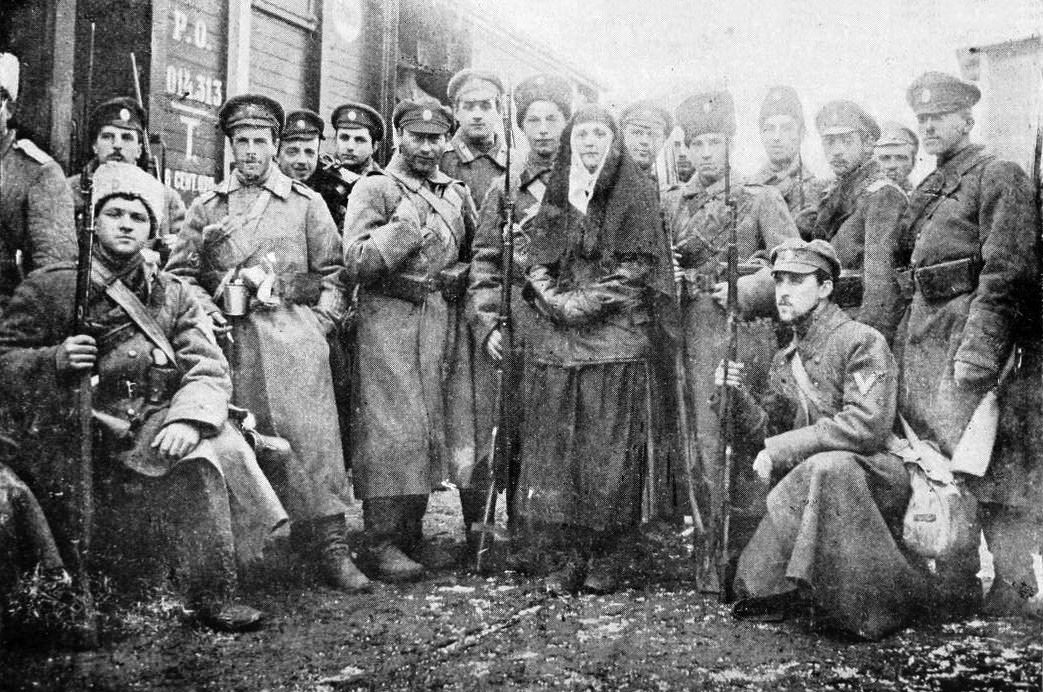 An Anti-Bolshevik volunteer army in the South of Russia in 1918. Starting during the end of Russian involvement in WWI, the Russian Empire saw massive uprisings and in 1917 there were 2 major Russian Revolutions. Almost immediately after the Russian Imperial system collapsed along with Nicholas II abdicating and the Soviets seizing full power after the October Revolution, the Russian Civil War began. With the Soviets in total control of the government, Russia removed itself from WWI, and large number of armed and angry soldiers formed for and against the Red Army. Many had already basically mutinied due to disastrous defeats in WWI, but that did not mean they were ready to accept communism and Soviet rule. Literally from the beginning of the Bolshevik rising, opposition to them from civilians and the army started. The Civil War lasted 5 and a half years and cost the lives of up to 3 million people, but could be higher as accurate totals were not compiled. In fact the last revolt related to the Civil War ended in 1934.
An Anti-Bolshevik volunteer army in the South of Russia in 1918. Starting during the end of Russian involvement in WWI, the Russian Empire saw massive uprisings and in 1917 there were 2 major Russian Revolutions. Almost immediately after the Russian Imperial system collapsed along with Nicholas II abdicating and the Soviets seizing full power after the October Revolution, the Russian Civil War began. With the Soviets in total control of the government, Russia removed itself from WWI, and large number of armed and angry soldiers formed for and against the Red Army. Many had already basically mutinied due to disastrous defeats in WWI, but that did not mean they were ready to accept communism and Soviet rule. Literally from the beginning of the Bolshevik rising, opposition to them from civilians and the army started. The Civil War lasted 5 and a half years and cost the lives of up to 3 million people, but could be higher as accurate totals were not compiled. In fact the last revolt related to the Civil War ended in 1934. -
5.
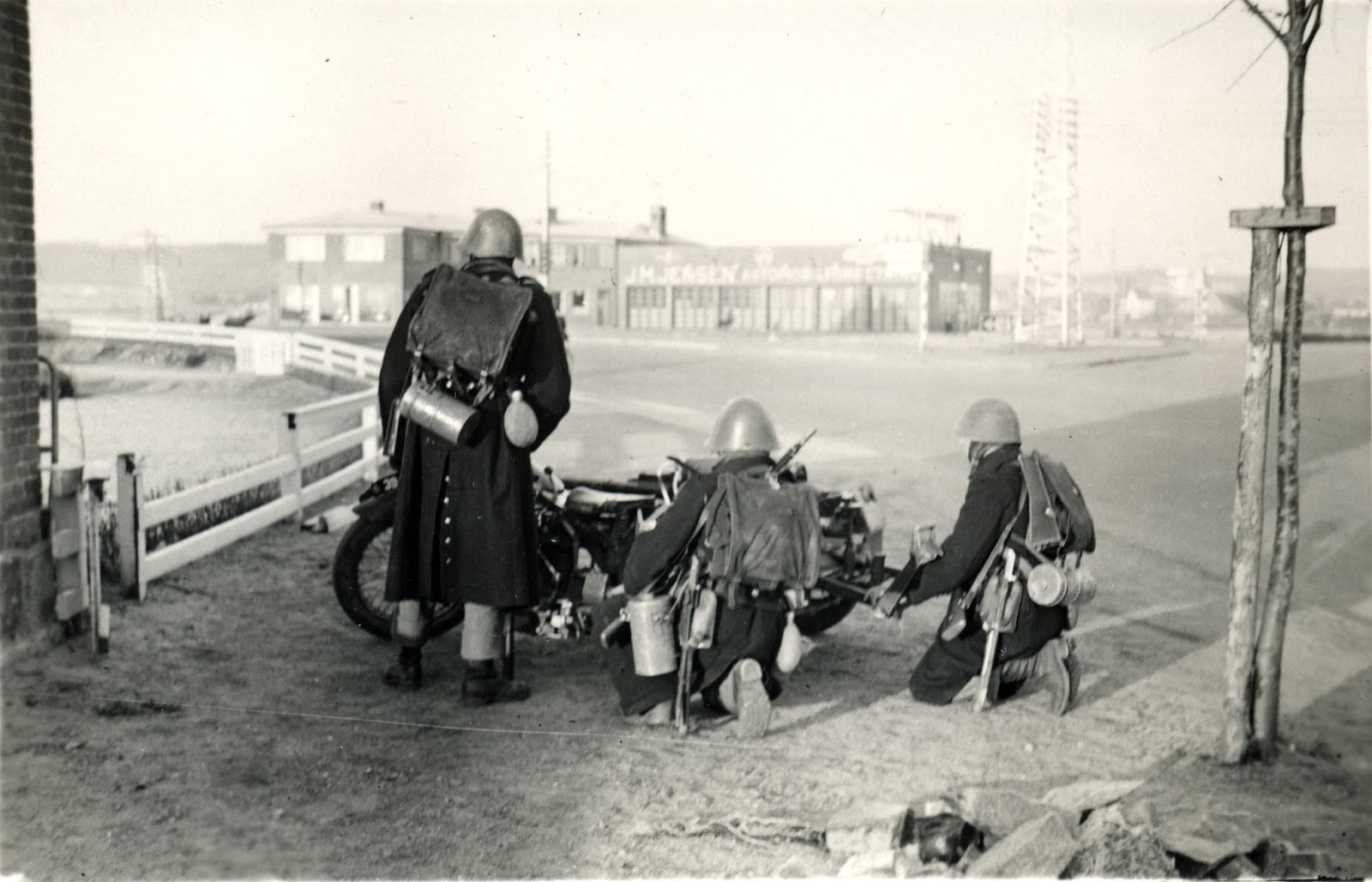 A motorcycle machine gun crew prepare to defend a road from a German advance during the German Invasion of Denmark in 1940. After defeating Poland, Germany invaded Denmark to secure the country for a planned invasion of Norway. The Danish garrison commanders wanted to deploy and setup defenses early. They had 15,000 men who may have been able to setup sturdy defenses in hopes of bottle-necking the German advance and perhaps gain support from other Danish units or even France and Britain. The Danish leaders refused to do any action that could be considered provoking the Germans. This meant when the Germans did invade, they had every advantage. Danish soldiers did deploy, and engaged German units. After 6 hours, the Danish government surrendered. Some Danish units continued to engage the Germans not knowing about the surrender. Around 50 people died total on all sides, with virtually no German bombing and no large scale engagements.
A motorcycle machine gun crew prepare to defend a road from a German advance during the German Invasion of Denmark in 1940. After defeating Poland, Germany invaded Denmark to secure the country for a planned invasion of Norway. The Danish garrison commanders wanted to deploy and setup defenses early. They had 15,000 men who may have been able to setup sturdy defenses in hopes of bottle-necking the German advance and perhaps gain support from other Danish units or even France and Britain. The Danish leaders refused to do any action that could be considered provoking the Germans. This meant when the Germans did invade, they had every advantage. Danish soldiers did deploy, and engaged German units. After 6 hours, the Danish government surrendered. Some Danish units continued to engage the Germans not knowing about the surrender. Around 50 people died total on all sides, with virtually no German bombing and no large scale engagements. -
6.
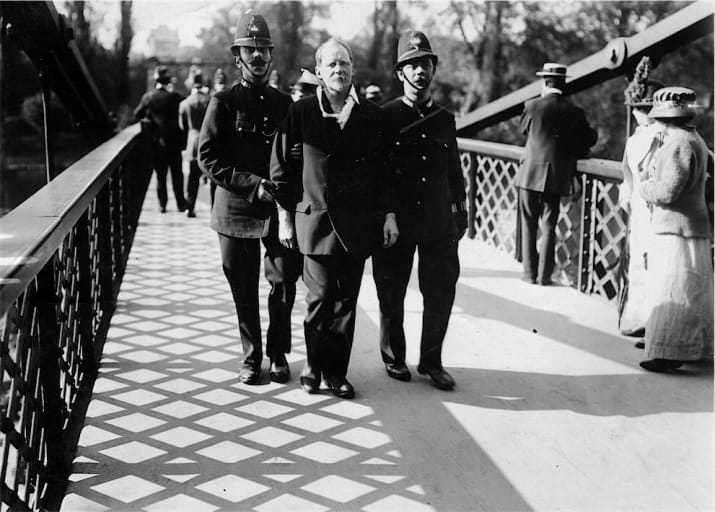 A male suffrage supporter being arrested during a rally in London, England in 1912. For many years, massive number of protests took place in London, pushing for more women rights and the right to vote. Many pictures from those times show the brave women involved in the marches. But thousands of men also participated, and were instrumental in the movement. Male leaders such as parliament members John Stuart Mill (who was the first to call for women's suffrage) and Arnold Stephenson Rowntree as well as other leaders such as Laurence Housman, Claude Hinscliff, and Gerald Gould helped gain other male support that was a major factor in the suffrage movement.
A male suffrage supporter being arrested during a rally in London, England in 1912. For many years, massive number of protests took place in London, pushing for more women rights and the right to vote. Many pictures from those times show the brave women involved in the marches. But thousands of men also participated, and were instrumental in the movement. Male leaders such as parliament members John Stuart Mill (who was the first to call for women's suffrage) and Arnold Stephenson Rowntree as well as other leaders such as Laurence Housman, Claude Hinscliff, and Gerald Gould helped gain other male support that was a major factor in the suffrage movement. -
7.
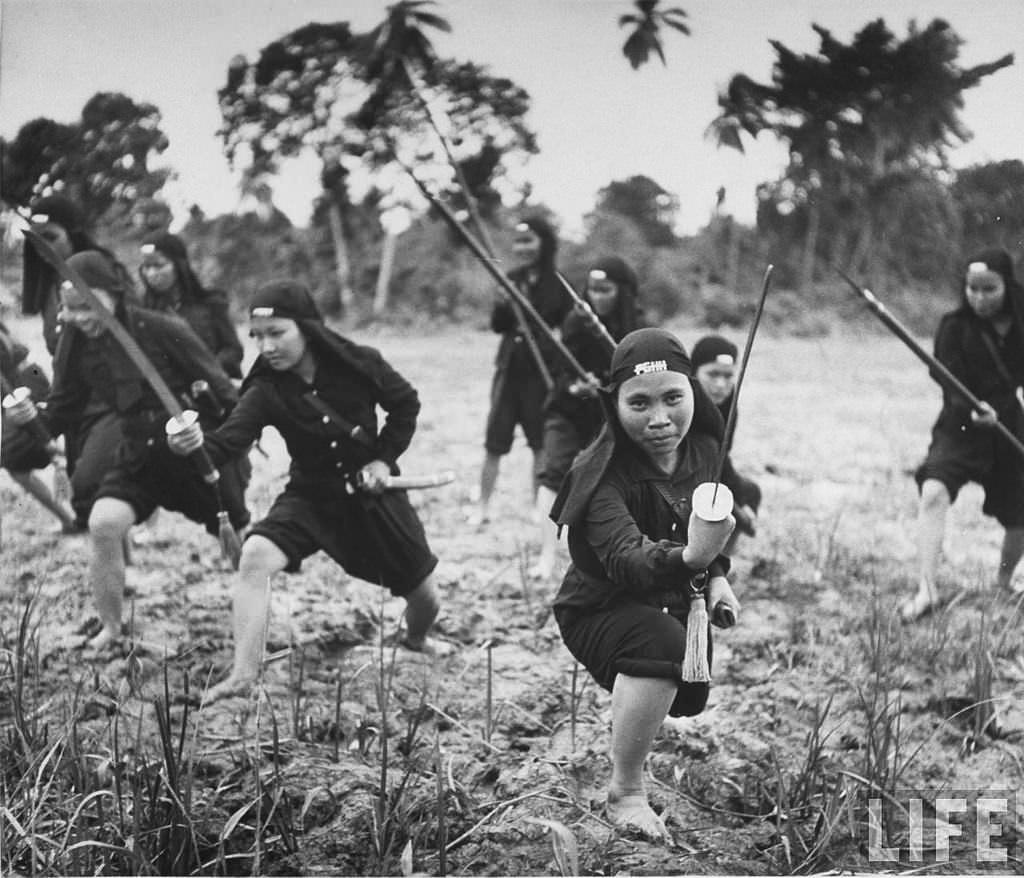 Hoa Hao women fighters training for jungle combat in French Indochina in 1948. LIFE magazine took these pictures of women units trained by the French to help combat possible insurgents in the heavy jungle of French Indochina. They would be trained with spears and swords as well as guns. Most of the pictures from this shoot has the women showing off their swords and spears. The First Indochina War (part of WWII), the Second Indochina War, and the Vietnam War saw heavy jungle combat. Women were heavily involved in all 3 wars and in the last 2 on both sides, being trained for combat and used in a variety of ways against the enemy.
Hoa Hao women fighters training for jungle combat in French Indochina in 1948. LIFE magazine took these pictures of women units trained by the French to help combat possible insurgents in the heavy jungle of French Indochina. They would be trained with spears and swords as well as guns. Most of the pictures from this shoot has the women showing off their swords and spears. The First Indochina War (part of WWII), the Second Indochina War, and the Vietnam War saw heavy jungle combat. Women were heavily involved in all 3 wars and in the last 2 on both sides, being trained for combat and used in a variety of ways against the enemy. -
8.
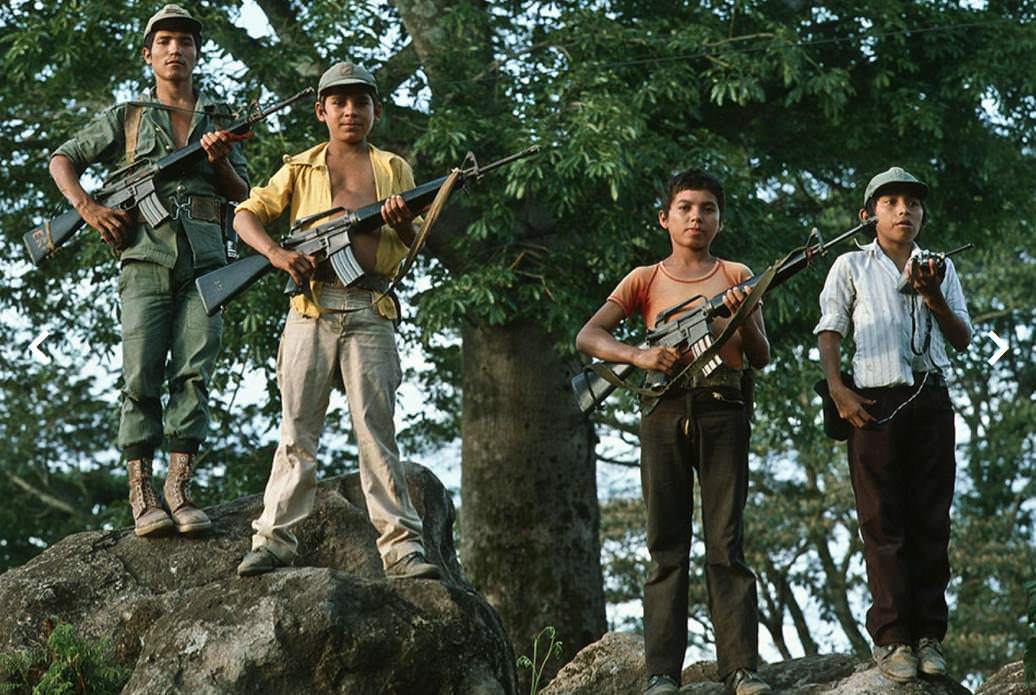 3 FMLN Child soldiers with their commander pose for a picture in El Salvador in 1983. The FMLN guerillas forced children into their ranks, and rarely did anyone have a choice. This all occured during the El Salvadorian Civil War, with lasted from 1979 all the way until 1992. Eventually the FMLN and their supporters lost and were disbanded. Both sides committed crimes against civilians, but the FMLN and other rogue factions had death squads that were brutal. Their activities along with forced conscription caused 1/5 of the entire countries population to be displaced, with many fleeing to the US. Less than 30,000 people died in actual fighting during the 13 year war, but up to 100,000 civilians were killed, many by those said death squads.
3 FMLN Child soldiers with their commander pose for a picture in El Salvador in 1983. The FMLN guerillas forced children into their ranks, and rarely did anyone have a choice. This all occured during the El Salvadorian Civil War, with lasted from 1979 all the way until 1992. Eventually the FMLN and their supporters lost and were disbanded. Both sides committed crimes against civilians, but the FMLN and other rogue factions had death squads that were brutal. Their activities along with forced conscription caused 1/5 of the entire countries population to be displaced, with many fleeing to the US. Less than 30,000 people died in actual fighting during the 13 year war, but up to 100,000 civilians were killed, many by those said death squads. -
9.
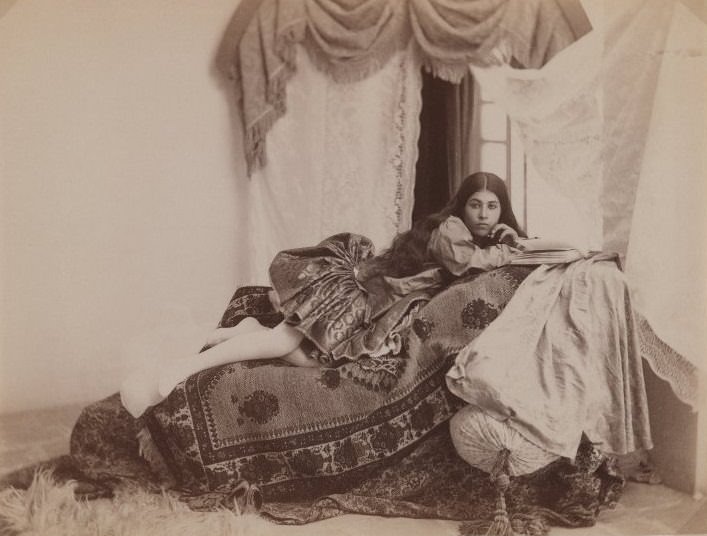 A Persian prostitute that was basically a slave in 1900. Prostitution, the oldest profession in the world, was also everywhere in the world until the early part of the 20th century, as countries began a pious push to remove legal prostitution. In Persian areas at the time, prostitutes had no rights, and were basically owned by their handlers. They received minimal wages, if at all, and often had no escape until released due to age, death of the owner, or other factors. Pregnancies rarely allowed a prostitute to stop working. Many countries such as England, France, and the US had variations of ownership of prostitutes too, with legal contracts forcing the women to whore themselves for a long number of years with no way to void the contract themselves. This removed all their rights, making them a form of a slave, and subjecting them to anything their boss/owner wished.
A Persian prostitute that was basically a slave in 1900. Prostitution, the oldest profession in the world, was also everywhere in the world until the early part of the 20th century, as countries began a pious push to remove legal prostitution. In Persian areas at the time, prostitutes had no rights, and were basically owned by their handlers. They received minimal wages, if at all, and often had no escape until released due to age, death of the owner, or other factors. Pregnancies rarely allowed a prostitute to stop working. Many countries such as England, France, and the US had variations of ownership of prostitutes too, with legal contracts forcing the women to whore themselves for a long number of years with no way to void the contract themselves. This removed all their rights, making them a form of a slave, and subjecting them to anything their boss/owner wished. -
10.
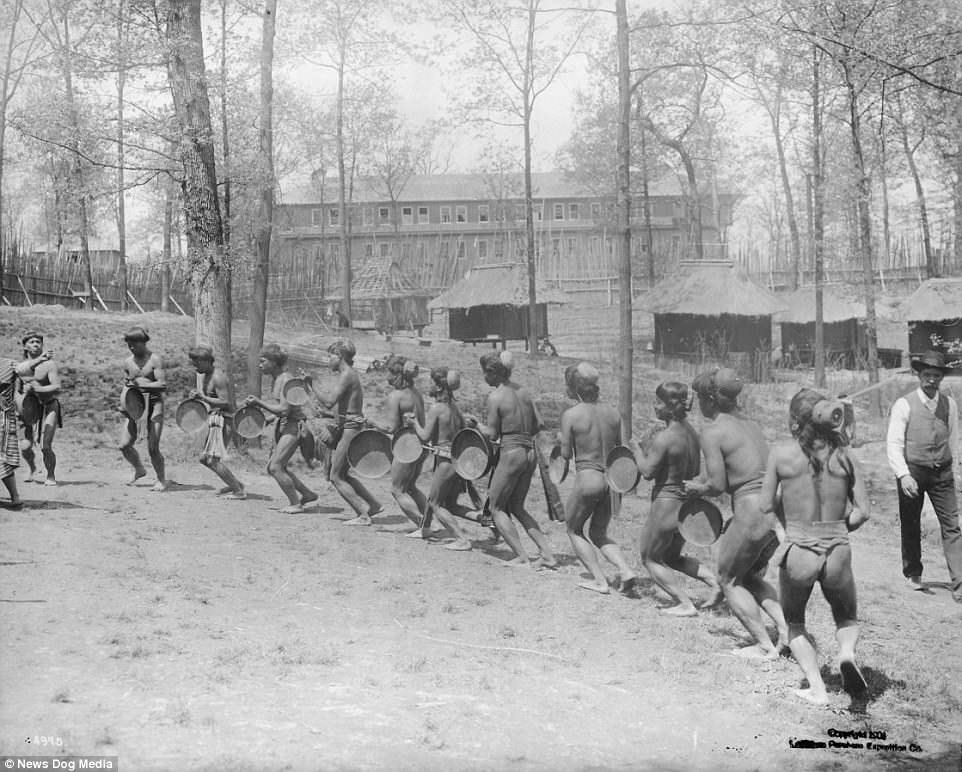 Igorot men from the Philippines, wearing loincloths and carrying hand drums, dance at the Louisiana Purchase Exposition in the US in 1904. This is a form of a human zoo. After defeating Spain in 1898, the US took control of the Philippines and transported local tribes to the US to display in human zoos. They also sold some to Europe for their own human zoos. Germany, Holland, Belgium and the UK had large scale human zoos at one point. The zoos were looked upon by their proprietors and patrons as a way to see different cultures from around the world in a form of their natural habitat. What it really was instead was a form of enslavement, as the participants had no rights. They would be kidnapped or tricked into leaving their homelands, forced to do similar activities (as pictured above) on command, and were paraded as ignorant and inferior people. They were not paid, and could even be separated from family for financial purposes. The last human zoo was at the Worlds Fair in Brussels, Belgium in 1958.
Igorot men from the Philippines, wearing loincloths and carrying hand drums, dance at the Louisiana Purchase Exposition in the US in 1904. This is a form of a human zoo. After defeating Spain in 1898, the US took control of the Philippines and transported local tribes to the US to display in human zoos. They also sold some to Europe for their own human zoos. Germany, Holland, Belgium and the UK had large scale human zoos at one point. The zoos were looked upon by their proprietors and patrons as a way to see different cultures from around the world in a form of their natural habitat. What it really was instead was a form of enslavement, as the participants had no rights. They would be kidnapped or tricked into leaving their homelands, forced to do similar activities (as pictured above) on command, and were paraded as ignorant and inferior people. They were not paid, and could even be separated from family for financial purposes. The last human zoo was at the Worlds Fair in Brussels, Belgium in 1958. -
11.
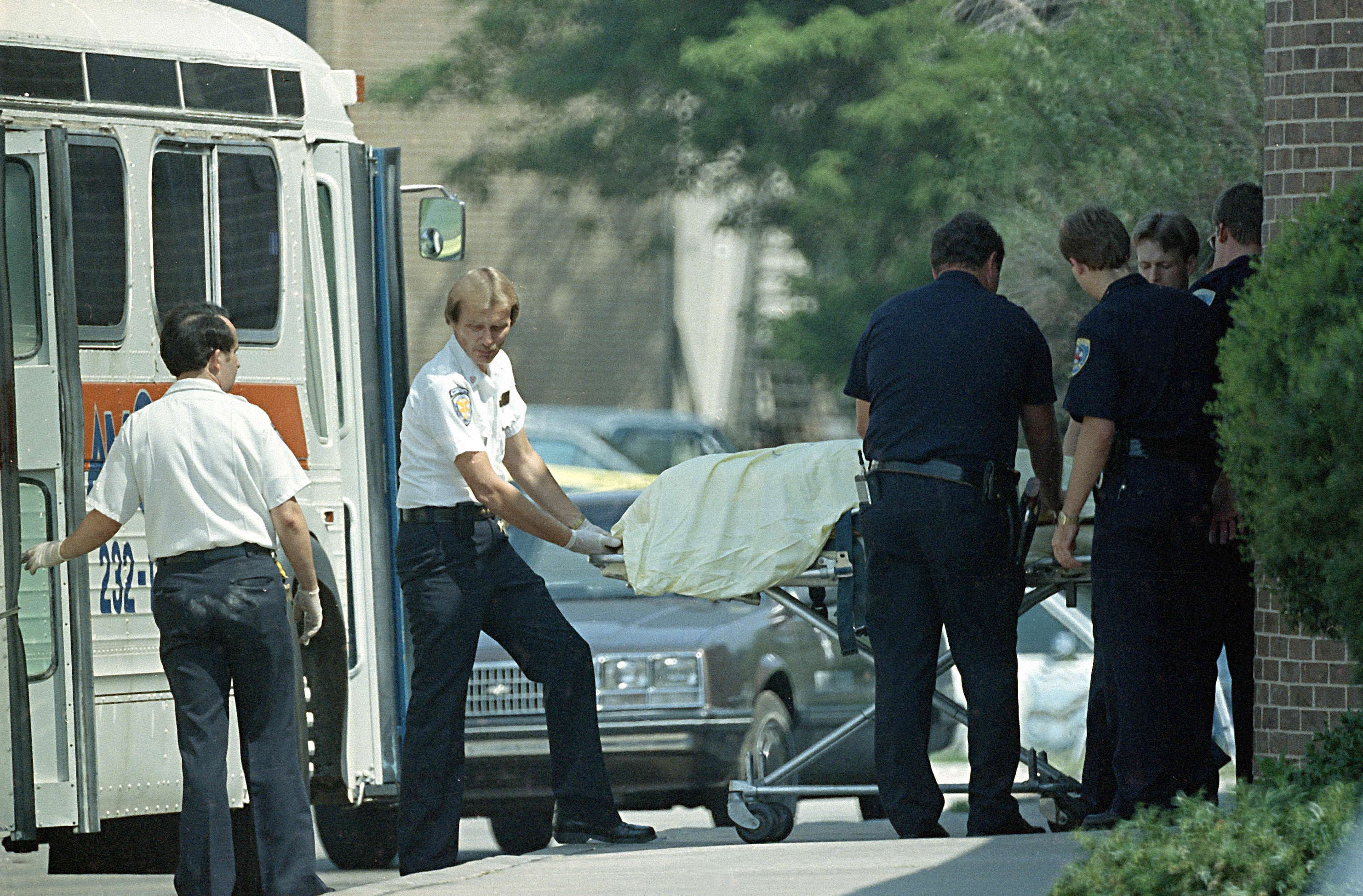 Police and emergency personnel wheel out a body after the Edmond Post Office Shooting in Edmond, Oklahoma, US in 1986. A postal worker named Patrick Sherrill entered the building and in 15 minutes hunted and shot 20 former coworkers. He killed 14 of them before he committed suicide as police began to surround the building. Motives for his actions are debated, but many presume he was to be fired after a mistake the previous day and committed the shootings when the anxiety took him over. At the time it was 3rd worst mass shooting in the US. The event shocked the nation, and any term today referring to "going postal" is a direct reference to this shooting.
Police and emergency personnel wheel out a body after the Edmond Post Office Shooting in Edmond, Oklahoma, US in 1986. A postal worker named Patrick Sherrill entered the building and in 15 minutes hunted and shot 20 former coworkers. He killed 14 of them before he committed suicide as police began to surround the building. Motives for his actions are debated, but many presume he was to be fired after a mistake the previous day and committed the shootings when the anxiety took him over. At the time it was 3rd worst mass shooting in the US. The event shocked the nation, and any term today referring to "going postal" is a direct reference to this shooting. -
12.
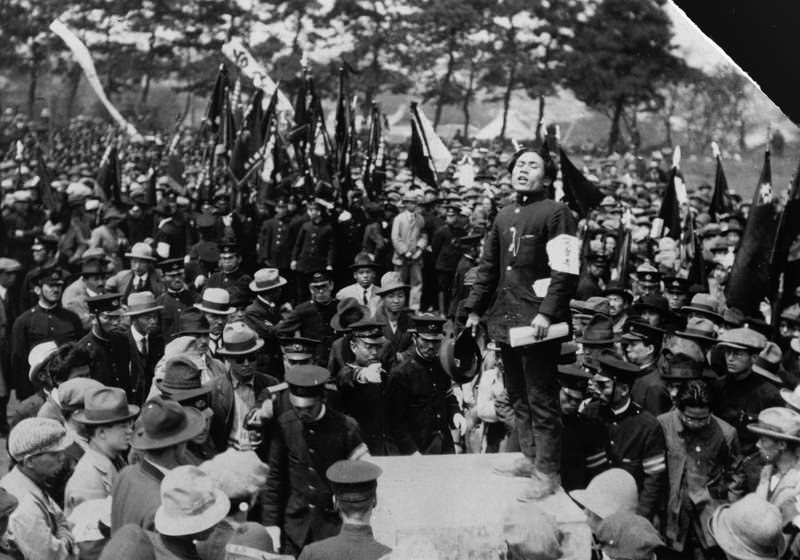 Working class men organize a protest against labor issues in Japan in 1925. Imperial Japanese rule had labor issues throughout the 1920s, and it caused unrest at home. Most of the demonstrations were from the work force, eager for better government programs and solutions to the labor issues. When Japan prepared to be more aggressive against other nations, it also increased their industrial areas, giving such people as these the jobs they desired. Germany, France, England, Japan, and the US, among other countries, all had labor issues around the 1920s and 30s solved mainly by industrialization of the country in preparation for war. In this protest, no one would be killed, but some did clash with police and some violence took place. Also, about 150 were arrested.
Working class men organize a protest against labor issues in Japan in 1925. Imperial Japanese rule had labor issues throughout the 1920s, and it caused unrest at home. Most of the demonstrations were from the work force, eager for better government programs and solutions to the labor issues. When Japan prepared to be more aggressive against other nations, it also increased their industrial areas, giving such people as these the jobs they desired. Germany, France, England, Japan, and the US, among other countries, all had labor issues around the 1920s and 30s solved mainly by industrialization of the country in preparation for war. In this protest, no one would be killed, but some did clash with police and some violence took place. Also, about 150 were arrested. -
13.
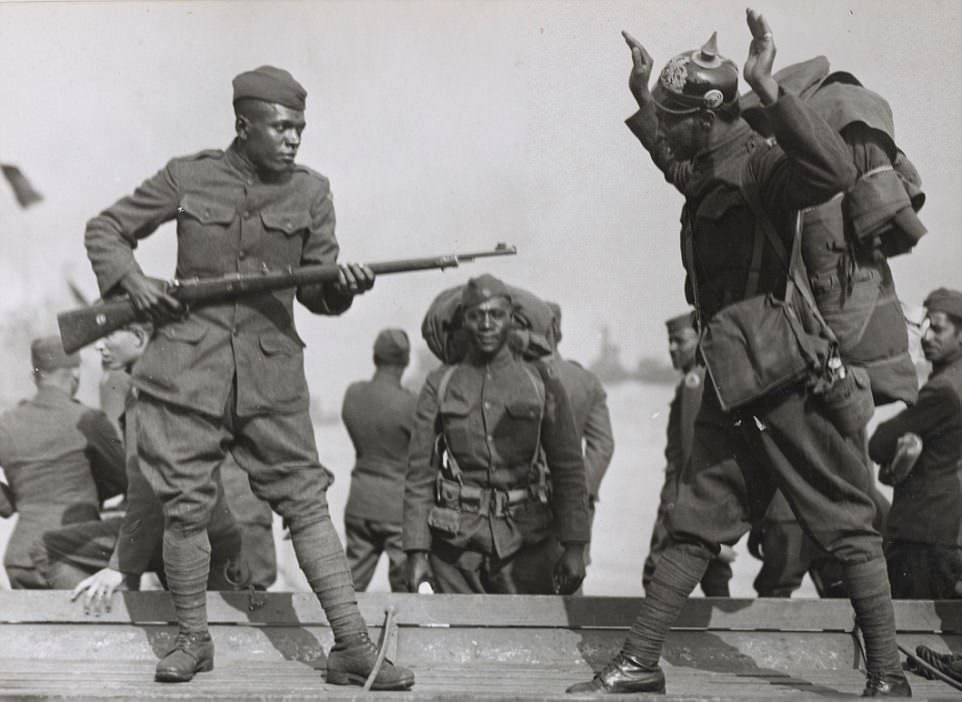 Black American soldiers goof off in France during WWI in 1917. When the US entered WWI, only 4 black soldier units known as 'colored' units existed in the US military. President Woodrow Wilson called up volunteers, including setting a quota for black soldiers. Within a week of the first request, 1 million black men volunteered for the army, forcing them to stop accepting applications as the massive number of volunteers more than quadrupled the US Army's desired quota. Some 800,000 black volunteers were at first denied. By wars end, around 370,000 black American soldiers took part in WWI, many in heavy engagements.
Black American soldiers goof off in France during WWI in 1917. When the US entered WWI, only 4 black soldier units known as 'colored' units existed in the US military. President Woodrow Wilson called up volunteers, including setting a quota for black soldiers. Within a week of the first request, 1 million black men volunteered for the army, forcing them to stop accepting applications as the massive number of volunteers more than quadrupled the US Army's desired quota. Some 800,000 black volunteers were at first denied. By wars end, around 370,000 black American soldiers took part in WWI, many in heavy engagements. -
14.
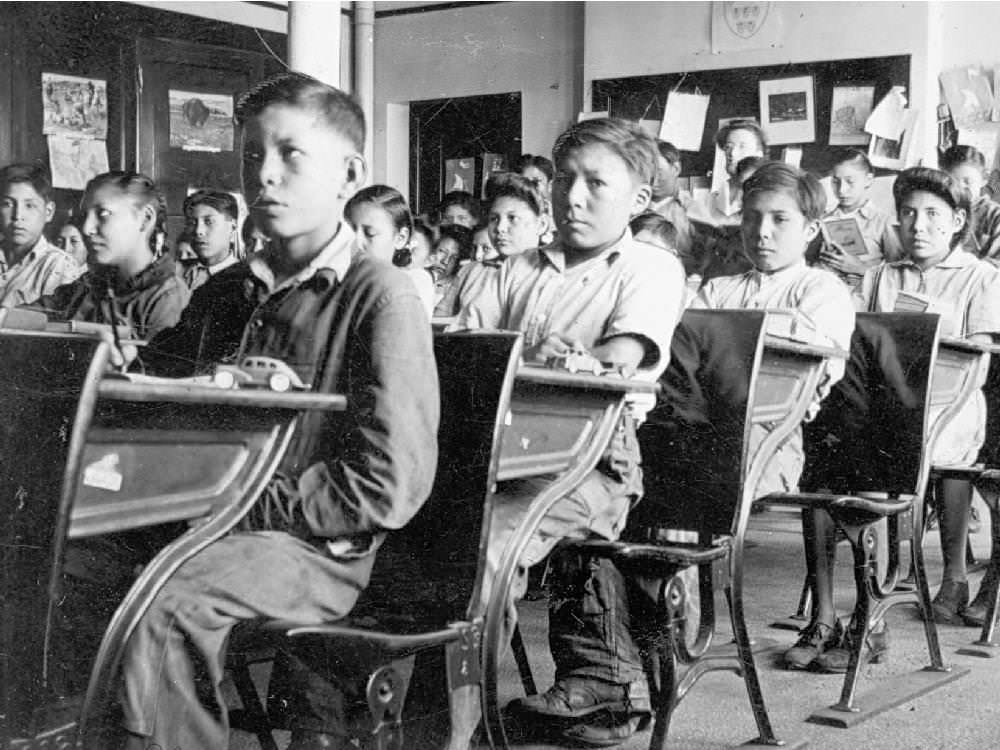 Native Blackfoot Indians in a school on their reservation in Alberta, Canada in 1904. Some Native American tribes were in some cases wiped out in North America by diseases and wars. With other tribes, their total population were drastically reduced. The US and Canada has had many ugly moments when their governments would takeover lands, subjugate the people, enforce expulsion from their lands, and even large massacres of Native Americans throughout its history (the massacres mostly occurring in US conflicts however). Then, to "culture" the Natives, they forced them into schooling programs, proper modern dress and living arrangements, and other ways that destroyed the Native American heritage. For example, in this school pictured, the children would be required to speak English only and wear nothing from their native culture. The Blackfoot tribes themselves were oppressed from both the US and Canada, with even a bloody massacre at the hands of US troops in when 173 women, children and elderly were slaughtered in 1870. Only 1 US soldier died, but it was from complications of breaking his leg when he fell from his horse. This is one of the only massacres involving Native Americans that virtually had zero US soldier casualties, showing that group clearly was of no threat.
Native Blackfoot Indians in a school on their reservation in Alberta, Canada in 1904. Some Native American tribes were in some cases wiped out in North America by diseases and wars. With other tribes, their total population were drastically reduced. The US and Canada has had many ugly moments when their governments would takeover lands, subjugate the people, enforce expulsion from their lands, and even large massacres of Native Americans throughout its history (the massacres mostly occurring in US conflicts however). Then, to "culture" the Natives, they forced them into schooling programs, proper modern dress and living arrangements, and other ways that destroyed the Native American heritage. For example, in this school pictured, the children would be required to speak English only and wear nothing from their native culture. The Blackfoot tribes themselves were oppressed from both the US and Canada, with even a bloody massacre at the hands of US troops in when 173 women, children and elderly were slaughtered in 1870. Only 1 US soldier died, but it was from complications of breaking his leg when he fell from his horse. This is one of the only massacres involving Native Americans that virtually had zero US soldier casualties, showing that group clearly was of no threat. -
15.
 A picture of the harbor at Texas City, Texas, US after a massive explosion aboard the French-registered vessel SS Grandcamp caused a chain reaction that wiped out much of the ships, factories, and some homes near the port in 1947. The SS Grandcamp had a fire while docked, and her cargo of approximately 2,200 tons of ammonium nitrate detonated. The blast was one of the largest non-nuclear explosions ever, and the result spread to the industrial area of the port city. Fire after fire and other small explosions continued until it finally ended after almost a day. People worked nonstop to try and stop the spreading but mostly had to wait for the fires to burn out. Every ship in the port at the time and every building within half a mile of the SS Grandcamp was pretty much destroyed.
A picture of the harbor at Texas City, Texas, US after a massive explosion aboard the French-registered vessel SS Grandcamp caused a chain reaction that wiped out much of the ships, factories, and some homes near the port in 1947. The SS Grandcamp had a fire while docked, and her cargo of approximately 2,200 tons of ammonium nitrate detonated. The blast was one of the largest non-nuclear explosions ever, and the result spread to the industrial area of the port city. Fire after fire and other small explosions continued until it finally ended after almost a day. People worked nonstop to try and stop the spreading but mostly had to wait for the fires to burn out. Every ship in the port at the time and every building within half a mile of the SS Grandcamp was pretty much destroyed. -
16.
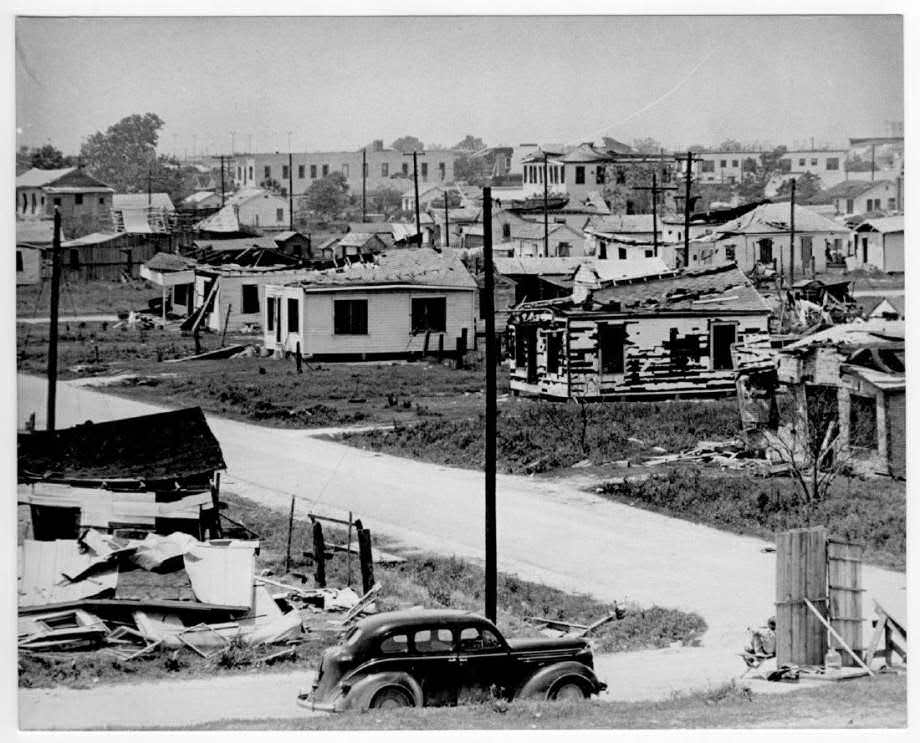 Continuing from the previous picture, here is what is left of some homes caught in the blasts after the Texas City Disaster in Texas, US in 1947. A total of 581 people died, with 63 never being identified as the bodies burned beyond recognition. Another near 8,000 were injured or affected badly. Also, 27 of the 28 men of the city's fire department were killed fighting the fires after the first blast trying to avoid additional fires and explosions, which they could not. In response to this disaster, the first ever class action lawsuit in the US was filed, when the US government was sued on behalf of the 8,485 total victims caught up in this disaster. The last claim was finalized in 1957, and a total of $17 million was paid out by the government. As it seems is always the case in the US after a disaster such as this, new laws went into place to properly inspect and police industrial ports to avoid a repeat.
Continuing from the previous picture, here is what is left of some homes caught in the blasts after the Texas City Disaster in Texas, US in 1947. A total of 581 people died, with 63 never being identified as the bodies burned beyond recognition. Another near 8,000 were injured or affected badly. Also, 27 of the 28 men of the city's fire department were killed fighting the fires after the first blast trying to avoid additional fires and explosions, which they could not. In response to this disaster, the first ever class action lawsuit in the US was filed, when the US government was sued on behalf of the 8,485 total victims caught up in this disaster. The last claim was finalized in 1957, and a total of $17 million was paid out by the government. As it seems is always the case in the US after a disaster such as this, new laws went into place to properly inspect and police industrial ports to avoid a repeat.
- REPLAY GALLERY
-

- 16 Fascinating Historical Photos That You Most Probably Had No Idea About
- NEXT GALLERY
-
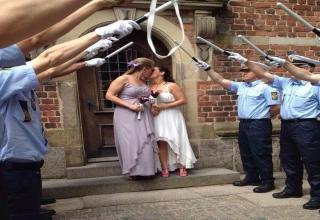
- 44 Captivating,Fascinating Images To Enjoy
This IRA propaganda picture shows female IRA members checking a loyalist civilian for arms in Northern Ireland in 1972. This was part of a number of pictures released by the IRA showing faceless women in action. The weapons and female IRA members are real, but the scenario is staged. This kind of picture was designed to give the impression the IRA was everywhere, and could be anyone at anytime. This was during the earlier stages of The Troubles, which lasted 30 years from 1968 through 1998. Throughout this time, female IRA members often played traditional roles such as secretaries or organizers, sometimes also as spies or support roles, but plenty were also active soldiers. As the Troubles ramped up, more women joined both sides. The IRA tends to be better known, but there was also a lot of Northern Irish people who joined loyalist factions or government agencies in efforts to suppress the IRA.
16/16
1/16
Categories:
Wow


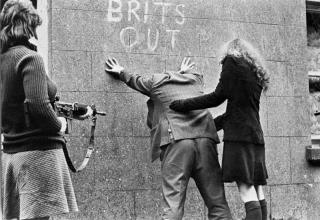
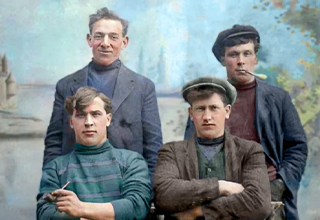


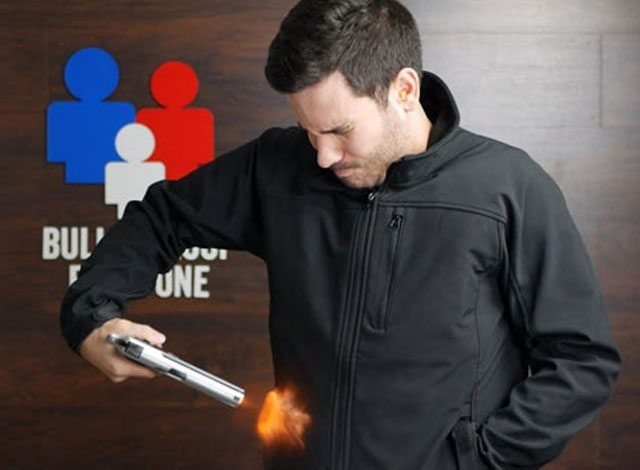

0 Comments